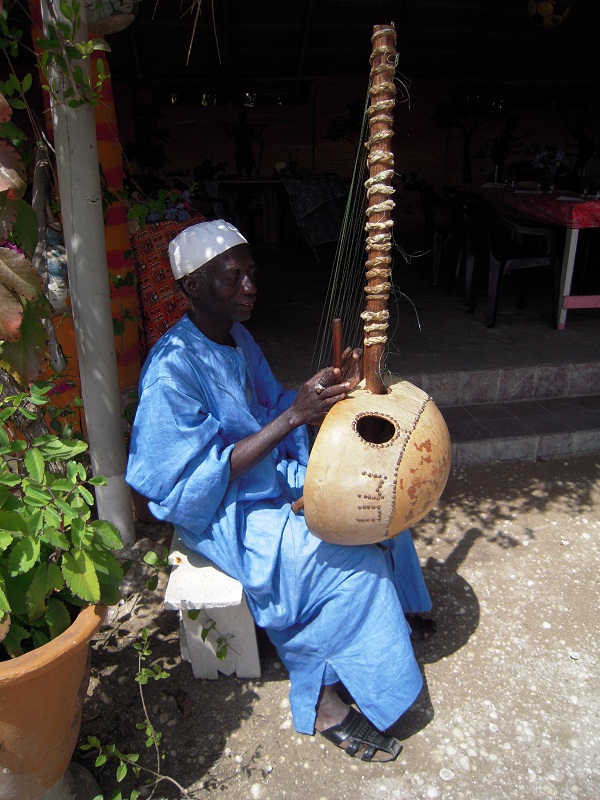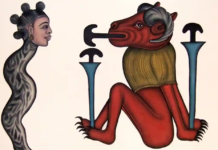The Kora is a 21-string lute–bridge–harp used extensively in West Africa. It is the most advanced of all modern string instruments in the world, requiring only gifted players to pluck its strings. Its precursor, the Guino’nta, a six string instrument developed in West Africa some 5,500 years BC did all but vanish after more strings were added on and more advanced players preferred the flexibility of the Kora.
Through out time and space the Guino’nta made its way to Europe and the rest of the world. It is now known as the guitar. Most European historians will claim they received the guitar through the Greeks. Only the Greeks borrowed it in the form of the lyre from Kemet (Ancient Egypt) and Nubia.
The Kora is a built from a large calabash cut in half and covered with cow skin to make a resonator with a long hardwood neck. The skin is supported by two handles that run under it, and it supports a notched double free-standing bridge.
 The Kora doesn’t fit into any one category of musical instruments, but rather several, and must be classified as a “double-bridge-harp-lute” if you wish to imagine it outside of West Africa. The strings run in two divided ranks, making it a double harp. They do not end in a soundboard but are held in notches on a bridge, making it a bridge harp. They originate from a string arm or neck and cross a bridge directly supported by a resonating chamber, making it a lute too.
The Kora doesn’t fit into any one category of musical instruments, but rather several, and must be classified as a “double-bridge-harp-lute” if you wish to imagine it outside of West Africa. The strings run in two divided ranks, making it a double harp. They do not end in a soundboard but are held in notches on a bridge, making it a bridge harp. They originate from a string arm or neck and cross a bridge directly supported by a resonating chamber, making it a lute too.
The sound of the Kora resembles that of a harp, though when played in the traditional style, it bears a closer resemblance to flamenco and delta blues guitar techniques of the New Orleans musical era. The player uses only the thumb and index finger of both hands to pluck the strings in poly-rhythmic patterns (using the remaining fingers to secure the instrument by holding the hand posts on either side of the strings). Ostinato riffs (“Kumbengo”) and improvised solo runs (“Birimintingo”) are played at the same time by skilled players.
Many instruments south of the Sahara Desert play ostinato melodies. These include lamellophones such as the mbira, as well as xylophones like the balafon, the bikutsi, and the gyil. Ostinato figures are also played on string instruments such as the gankoqui bell ensembles, and pitched drums ensembles. Often, African ostinatos contain offbeats or cross-beats, that contradict the metric structure. Other African ostinatos generate complete cross-rhythms by sounding both the main beats and cross-beats.
Kora players have traditionally come from griot families (also from the Mandinka nationalities) who are traditional historians, genealogists and storytellers who pass their skills on to their descendants. The instrument is played in Guinea, Guinea-Bissau, Mali, Senegal, Burkina Faso and the Gambia. A traditional kora player is called a Jali, similar to a ‘bard’ or oral historian. Most West African musicians prefer the term ‘jali’ to ‘griot’, which is a French alliteration.
Traditional koras feature 21 strings, eleven played by the left hand and ten by the right. Modern koras made in the Casamance region of southern Senegal sometimes feature additional bass strings, adding up to four strings to the traditional 21. Strings were traditionally made from thin strips of hide, for example antelope skin – now most strings are made from harp strings or nylon fishing line, sometimes plaited together to create thicker strings.
By moving leather tuning rings up and down the neck, a kora player can retune the instrument into one of four seven-note scales. These scales add in tuning to the major, minor and Lydian modes which are the only available modes popularly in music outside of West Africa.
In the late 20th century, a 25-string model of the kora was developed, though it has been adopted by only a few players, primarily in the region of Casamance, in southern Senegal. Some kora players such as Seckou Keita have double necked Koras, allowing them to switch from one tuning to another within seconds, giving them increased flexibility.
An electric instrument modeled on the Kora (but made primarily of metal) called the gravikord became popularized in the West in the late 20th century by Robert Grawi. It has 24 strings but is tuned and played differently than the Kora and many West African musicians out-rightly rejected its poor sound and dearth of flexibility.

Composers (oral tradition)
Mali : cordes anciennes / Mali : Ancient Strings, Sidiki Diabaté and Djelimadi Sissoko, Buda Music, 2000. First published in 1970, this CD was the first album totally devoted to the kora. Sidiki Diabaté was the father of Toumani Diabaté, and Djelimadi Sissoko was the father of Ballaké Sissoko. They both recorded New Ancient Strings – Nouvelles Cordes Anciennes in 1999 (Hannibal), as a tribute to their fathers.
Gambie : l’art de la kora, Jali Nyama Suso, edited by Roderic Knight, Ocora, 1996. First published in 1972, this CD is also a historical recording.
Jali Kunda – Griots of West Africa & Beyond, Ellipsis Arts, 1996. A book and a CD edited by Foday Musa Suso, produced by Bill Laswell. Photographs by Daniel Lainé. A journey through traditional kora music and three original meetings: kora and piano (Spring Waterfall by Foday Musa Suso and Philip Glass) ; kora and synthesizers (Lanmbasy Dub, with Bill Laswell, bass, and Jeff Bova, synthesizers) ; kora and saxophone (Samma, a duet with jazz saxophonist Pharaoh Sanders).
The Mandé Variations, Toumani Diabaté, World Circuit, 2008. Twenty years after his first CD, Kaira (Hannibal, 1988) – that was also the first CD ever recorded with solo kora pieces without any song -, Toumani Diabate alternates traditional pieces on a kora with leather rings and his own creations with a special tuning on a kora with wooden pegs.

Musique: Stranded Horse (By Yann Tambour and Boubacar Cissokho)
Vincent Gibaud (Réalisation / Concept Art / Story-Board / Layout / Background / ColorScript)
Alizée Laffitau (Animation Fx / Chara-Design)
Yann Leroy (Composting / LightScript / Texturing / Lighting )
Charlotte Guittet (Rig / Animation 3D )
Victor Lacotte ( Animation 3D )
Julia Robin ( Animation 3D / Concept Art / Chara-Design)
Sound Design
Benjamin Gex-Fabry










What a fascinating instrument! And might I add an intimidating one just imagining how long it would take to master 21 strings!
I enjoyed reading this greatly. Thank you for sharing such wealth in African music.
The Kora is the most advanced instrument on Earth. Period
I think the piano is probably more advanced but I guess that too must have come from Africa? I think the plot to situate everything dear to civilization in Africa and with African origins is itself selfish, don’t you think?
Not at all. What is exactly wrong with the truth? More selfish is when the world tries to extricate the African origins of the instruments of civilization and situate it in some some fanciful Greece. That is selfish. Not the truth!
The Kora is the most advanced instrument the planet Earth would ever know. Is that a selfish thing to say? But it is not selfish that for 200 years the West has peddled around the lies about it source of civilization – which is Africa!
Here we are for once reading about a superior instrument that is West African, the Kora. Never in the press in Europe or America would they feature this instrument and speak so flowery about it. Thanks for writing this piece. This will stand the test of time.
The Kora is something else. It sure is a wonderful instrument. I tried learning how to play it and I failed terribly. So I respect the families who have passed this on from generation to generation. Thanks, I applaud you all.